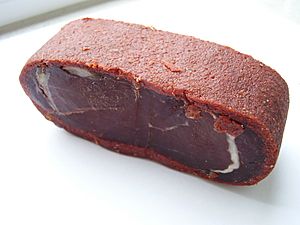Pastirma facts for kids
Pastirma (also called basturma or pastarma) is a very flavorful, air-dried beef. It's a popular food in many countries. You can find it in the cooking of Turkey, Armenia, Bulgaria, Egypt, Greece, Iraq, and North Macedonia.
Contents
What's in a Name? The History of Pastirma
The word Pastırma is very old. It's mentioned in books from long ago, like Diwan Lughat al-Turk and Seyahatname. Some experts believe the name pastirma comes from a Turkic word. This word, bastırma, means "pressing."
Some people think basturma first came from ancient Armenia. There, it was known as aboukh. A book called The Oxford Encyclopedia of Food and Drink says that pastırma was the Ottoman word. It was used for a type of cured beef from the Byzantine Empire. This meat was called paston.
Long ago, some armies carried dried and salted meat. This gave them an advantage over enemies who ate mostly grains. One writer, Ammianus Marcellinus, said the Huns would warm this meat. They placed it between their legs or on their horses' backs.
The English word "pastrami" might have come from "salami" mixed with "pastirma." Or it could be from similar words like pastramă in Romanian or pastromá in Russian.
How Pastirma is Made and Eaten
Pastirma is usually made from beef or water buffalo. But it can also be made from lamb, goat, or even camel meat in places like Egypt. Different parts of the animal can be used. The best quality pastirma often comes from the fillet, shank, leg, or shoulder. It's usually made in October and November.
Making pastirma takes about a month. First, the meat is rinsed and salted. Then it's dried and pressed. The first pressing can last up to 16 hours. This helps remove moisture from the meat. After this, the meat dries for several days. During this time, fats melt and form a white layer.
Finally, the dried meat is covered with a special spice paste called çemen. This paste is made from ground fenugreek seeds, chili powder, and crushed garlic. The meat is covered with this wet paste and left to dry again.
This long process helps keep the meat fresh. The çemen paste also helps stop mold from growing. It gives pastirma its special flavor and a bright red color.
Pastirma in Different Cuisines
Pastirma is a key part of many traditional foods. It shows up in Armenian, Egyptian, Turkish, and other Middle Eastern dishes.
Armenia
Armenians call this cured meat basturma or aboukht. It's similar to Italian bresaola. In Los Angeles, a famous Armenian deli called Sahag's Basturma is known for its basturma. The owner's family has been making it for three generations. They serve basturma as a sandwich with pickles and onions. Some Armenian pizzerias even put basturma on their pizzas!
Armenians who moved to the Middle East after 1915 brought basturma with them. Many Armenians from Kayseri were especially good at making basturma. The strong smell of basturma, from the garlic and fenugreek, was sometimes joked about. But it's a beloved part of Armenian culture. Armenian families in Palestine often eat basturma on New Year's Eve.
Bulgaria
In Bulgaria, it's called pastarma. This food arrived in Bulgaria around the 7th century. There's a special Bulgarian pastarma called Pastarma Govezhda. It was officially recognized in the EU in 2017 as a Traditional Speciality.
Turkey
In Turkish cooking, pastırma is often eaten for breakfast. It's a common ingredient in omelets and menemen (a Turkish egg dish). Pastırma can also be served as a meze, which is a small appetizer.
You can find pastırma as a topping on hummus, pide bread, and hamburgers. It's also used in toasted sandwiches with cheese. Sometimes, it's a filling for börek, a savory pastry. It can be mixed with potatoes for börek fillings too.
Pastırma is also added to many traditional vegetable dishes. These include tomato and white bean stew (called kuru fasulye). It's also used with cabbage, chickpeas, asparagus, and spinach. You can even find it in cheesy pull-apart bread.
Where Pastirma is Made
Turkey produces a lot of pastırma each year. The pastırma from Kayseri is especially famous. In 1893, a British report noted that Kayseri was well-known for making basturma. Kastamonu also produces a good amount of pastırma. The çemen paste there is made with local garlic from Taşköprü villages.
See also
 In Spanish: Pastırma para niños
In Spanish: Pastırma para niños


